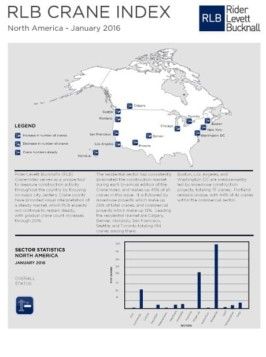The third edition of the North American RLB Crane Index®, which predicts construction growth in major cities by counting building cranes, forecasts industry activity to continue rise in 2016.
PHOENIX, AZ – Rider Levett Bucknall (RLB) – international property and construction consultants and industry leader in construction cost research – announced the release of the third edition of its North American RLB Crane Index®. The report measures construction activity in major cities across North America and predicts the health of the U. S. construction industry.
According to the new issue of the Index, the residential market continues to lead construction activity in the industry. Other notable sectors that are experiencing growth and contributing to overall activity are mixed-use, commercial, and hospitality projects.
“In nearly every city in our Index, residential developments continue to drive construction across North America at about 50% of total activity,” states Julian Anderson, president of RLB in North America. “Mixed-use projects account for nearly 30% of the overall activity and commercial projects for about 15%. Major projects across the U.S. and Canada – from new starts to projects on the boards – indicate that construction activity is steady and shows no signs of slowing down in 2016.”
Residential reigns supreme as mixed-use and commercial sectors continue steady growth.
The North American RLB Crane Index® reports that Calgary, Denver, Honolulu, San Francisco, Seattle, and Toronto are leading activity in the residential market with a total of 194 cranes active in that sector across these six cities. In Boston, Los Angeles, and Washington D.C. mixed-use construction leads construction activity with 111 cranes in total. Portland remains unique with 44% of its cranes within the commercial sector. The Index further reports that:
- Denver’s construction market continues to prosper with total crane counts doubling over the last year, and activity in the residential sector accounting for 53% of the city’s crane count. Statewide, according to the University of Colorado Leeds School of Business 2016 Economic Outlook, a 16% increase in residential construction and a 9% increase in non-residential construction is anticipated, while over 10,000 construction jobs are expected to be added to the Colorado market in 2016
- In Los Angeles, 2016 will continue to be a strong year for construction. Mixed-use and residential projects account for 80% of development downtown. The University of Southern California has a total of six tower cranes on three major student housing projects. Seven cranes are active in Hollywood on major mixed-use, hospitality and residential projects, and activity in the Beverly Hills area is ramping up with new construction and renovations, including the redevelopment of the Beverly Hilton Hotel
- Honolulu’s residential sector accounts for around 80% of crane activity, followed by hospitality, commercial, and mixed-use projects. Increases in construction costs have left many developers revisiting their programs, designs, and associated return on investment before committing to construction starts. Many current projects are expected to complete in 2016, and RLB foresees the city’s crane count reducing over the next six months
- San Francisco shows an increase in mixed-use projects by 17%, even as residential projects continue to lead activity. The majority of cranes remain concentrated in SoMa, with new developments along Van Ness increasing in the residential and healthcare markets
- Although RLB anticipates a slowdown of activity in Toronto over the next six months, the city is slated to add over 260 high-rise projects to its future market. Residential projects account for over 80% of the crane count year-to-date
- In Calgary, residential markets are responsible for 64% of the city’s cranes. It is anticipated that future market growth will be affected by the fall in oil prices, resulting in a downturn in construction in the near future.
- Seattle has seen a 43% increase in crane counts since this time last year, led by the commercial, mixed-use, and residential sectors combined. Over 9,000 residential units were added to the Seattle market in the last three years. RLB expects that activity has not yet peaked and will continue to climb in all sectors.
RLB’s local offices gather data and information for the Index via surveys and other collection methods, including physically counting all fixed cranes appearing on each city’s skyline. This count is performed twice yearly and provides the baseline data for the Index.
FURTHER INFORMATION:



